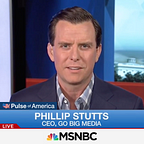The Moonshot Chapter 7 — Finding A Lifeline
It was like throwing a fishing line in a big ocean and hoping to catch a very specific shark.
This year I was inspired to take massive action in an effort to be cured of my disease, Achalasia, in five years. This is a multi-series blog on my fight. Click here to read my other posts.
“Hi, Philip. This is Nancy Lazarus calling. I just read an article of yours. I am the founder of Achalasia Awareness. I would absolutely love to talk to you. I am a die hard Achalasia advocate and I would absolutely love to talk to you, okay.”
This was the voicemail I received on March 8, 2017. Since my Inc. article had been published I had over 50 messages from friends, family and strangers. All were positive, kind, loving and heartfelt (Still to this day, people are reaching out to me over the article and I’m blown away by the support. It motivates me to fight harder and I also greatly appreciate that people aren’t afraid to ask me about it. I guess writing a national article gives others permission to inquire about my health and I love that).
When I originally wrote the Inc. article my outcome was to get exposure to my rare disease — to take control of Achalasia by seeking help. It was like throwing a fishing line in a big ocean and hoping to catch a very specific shark. Nothing was going to change unless I was willing to cast the line into the water. While I was grateful for the kind words and concern of family and friends, I wanted outsiders to read it, spread it, and hopefully someone somewhere would find it and reach out.
Still, after receiving the voicemail from Nancy, I was initially hesitant to call her back. A big human flaw of mine is being suspicious of other people’s motives — instead of seeing Nancy as a kind soul who was reaching out to help, I was apprehensive. I wanted help from strangers but was reluctant to accept the potential help of this stranger. What a contradiction. But I quickly forced myself to turn it around and identified that my instincts are sometimes terribly wrong.
So after a few days I reached out to Nancy and we began talking. She had suffered from Achalasia for many years and created the Achalasia Awareness Organization to serve as a resource for those that suffer from the disease.
I’m so glad I reached out to Nancy too. She was kind, funny and caring — and I instantly liked her. We began our conversation by telling war stories of our many surgeries, the painful effects of the disease on every day life and our quest to cure and incurable disease. There was an instant bond.
The stem cell path I was pursuing was interesting to her — so much so, she offered to reach out to her best medical contacts — Achalasia specialists from The Cleveland Clinic, Stanford University and her esophageal doctors in Los Angeles. We hung up and planned to talk again the following week. I had no expectation after the call, but I did think, maybe this will help — maybe Nancy will be a lifeline for me.
The following week, Nancy and I reconnected and she had some interesting information. The specialists she spoke with, all recommended we talk to a doctor at Johns Hopkins who is considered foremost researcher in the country on Achalasia — Jay Pasricha (a doctor I never knew or heard of when I was a patient at Johns Hopkins from 2012–2014).
Nancy’s determination led her to speak with Dr. Pasricha within a few days. She explained my case and my pursuit for a cure with stem cell treatments overseas. Dr. Pasricha explained that he had worked on this issue for decades and was convinced a cure was possible within five years.
Nancy called me immediately and shared the news and a week later I was on the phone with Dr. Pasricha. My conversation was fascinating because for the first time, I felt like I was peeling an Achalasia onion, not just trying to take a massive bite out of it. I was now learning more about the disease, the good and bad of my own situation, and the outlook of the disease for the future.
It definitely wasn’t all roses for me either. While Dr. Pasricha believed a cure was in the future — and was encouraged that stem cells treatments could be the answer — he wasn’t so sure about my situation. My history wasn’t tenable — three major surgeries where doctors sliced the esophageal muscle up and down. My esophageal muscles looked like an upside down pom-pom– if I can be even more hyperbolic, the muscle was shredded and covered with scar tissue.
Pasricha’s concern was that I may be “too far gone” and that Achalasia patients who were free of any surgeries would be the best candidates for a cure. He believed clinical trials and tests for a cure were coming in the future. Yet, I may not be eligible due to the damage inside my esophagus from past surgeries.
I asked Dr. Pasricha to at least consider me as a patient. He agreed but suggested I push the pause button on any type of overseas stem cell treatments (that weren’t FDA approved) and come under his care as he worked through my case. I agreed.
Phillip Stutts is founder & CEO of Go BIG Media, Inc., an award-winning media firm serving corporate and political clients around the world. He founded Go BIG Media on an ethos of service, excellence, and generosity, and with a mission to totally disrupt an industry. He is sharing his personal breakthrough to help you to take your own moonshot.
